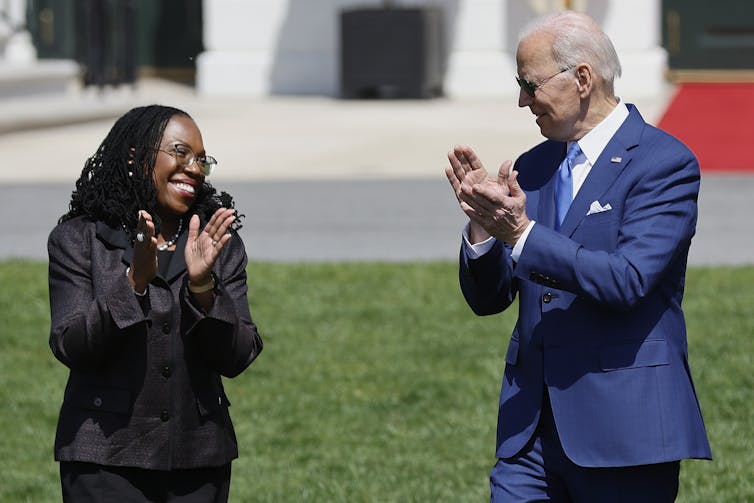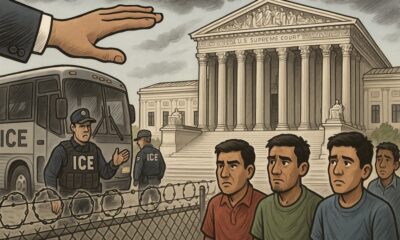
Arnie Sachs/CNP/Getty Images
Paul M. Collins Jr., UMass Amherst
President Joe Biden’s farewell to elected office on Jan. 20, 2025, presents an opportunity to reflect on the legacy he left on the federal courts.
Many will perceive Biden’s influence on the courts primarily based on his appointment of Ketanji Brown Jackson, the nation’s first Black, female Supreme Court justice.
But Biden’s judicial legacy spans decades and reaches far beyond the makeup of the current Supreme Court.
As a leading scholar of the federal courts, I believe Biden’s judicial impact is most notable in three regards: his role in the 1991 confirmation of Clarence Thomas, his historic efforts during his presidency to diversify the federal bench, and his 2024 decision to veto legislation expanding the number of federal district court judgeships.

Chip Somodevilla/Getty Images
Chairman Biden’s impact
When he was a senator, Biden served as the chair of the Senate Judiciary Committee from 1987 to 1995. During that time, Biden oversaw the Senate’s consideration of hundreds of federal court appointments, including six Supreme Court nominees.
His role in the 1991 confirmation hearing of Supreme Court Justice Clarence Thomas stands out for how he handled allegations of sexual harassment brought against the nominee.
Thomas was appointed by President George H.W. Bush to replace Thurgood Marshall, a liberal icon and the nation’s first Black Supreme Court justice.
Replacing the liberal Marshall with the conservative Thomas had the potential to shift the ideological makeup of the court. As a result, Thomas’ confirmation hearing was sure to be contentious.
But things got especially heated when Anita Hill, a former colleague of Thomas, alleged that Thomas had sexually harassed her when they both worked at the Department of Education and at the Equal Employment Opportunity Commission.
As chairman of the committee, it was ultimately up to Biden how to handle the investigation of these allegations.
Perhaps Biden’s most controversial decision involved his refusal to allow senators to hear from witnesses who were willing to testify under oath to corroborate Hill’s allegations. In a 2017 interview, Biden said that the witnesses backed out at the last minute. But this explanation is contested by at least one witness, who said she was never called to testify.
Though we’ll never be sure, this testimony could have sunk Thomas’ confirmation. Instead, he was confirmed by a 52-48 Senate vote.
Much later, Biden recognized that his handling of Hill’s allegations was going to be an issue in his 2020 presidential campaign. As a result, Biden reached out to Hill before announcing his candidacy. In that phone call, he expressed his regret for what she experienced at the hearing, but he did not go so far as to apologize.
Biden’s federal court appointments
As president, Biden’s primary legacy involves his historical efforts to diversify the federal bench in terms of the race, gender, sexual orientation and religion of his judicial nominees.
Biden appointed more women to the bench than any president before him, as well as the most racially and ethnically diverse group of judges in the nation’s history. Biden also appointed an unusually large number of former public defenders to judgeships.
Jackson, as a Black woman and former public defender, is the most high- profile example of this. But Biden also nominated more than a quarter of all sitting federal judges in his four years a president.
Biden’s efforts to diversify the federal bench are important and are likely to be tangible.
Having diverse judges on the courts increases support for courts among women and people of color. This is significant, since courts rely on the public for their legitimacy, and America has become increasingly diverse over time.
Female judges and judges of color tend to be more progressive in their decision-making than other judges, more often supporting litigants claiming violations of their civil rights. This is especially true for areas in which such judges may have unique perspectives and experiences, such as gender and racial discrimination.
Similarly, research shows that judges who were once public defenders are less likely to incarcerate convicted criminals and tend to hand down shorter sentences among those sentenced to prison.
The future of federal courts

One of Biden’s lesser known, but very substantial, final acts in office involves vetoing the JUDGES Act of 2024.
This legislation would have added 66 judges to the federal courts. Some of those courts are currently understaffed, resulting in heavy workloads for judges, creating delays in the administration of justice.
Though the bill had unanimous support in the Democratically controlled Senate in August 2024, the Republican-led House refused to vote on the bill until after the 2024 election.
This was a strategic move that would ensure that the winner of the election – Donald Trump – would appoint the initial batch of 25 judges under the legislation.
Biden said that he vetoed the legislation because there were some lingering questions that should be answered, such as how the new judgeships would be allocated to courts across the country.
But as a scholar of the federal courts, it is evident to me that Biden’s real motivation was to prevent Trump from appointing the first 25 judges.
Taken as a whole, Biden leaves a complicated legacy on the federal courts. On the one hand, he undertook unprecedented efforts to ensure that the federal courts look like the people they represent. He also resisted efforts that would have moved the courts in a conservative direction under Trump’s second term.
On the other hand, Biden played a major role in the confirmation of Thomas, one of the most conservative justices in American history.![]()
Paul M. Collins Jr., Professor of Legal Studies and Political Science, UMass Amherst
This article is republished from The Conversation under a Creative Commons license. Read the original article.























































